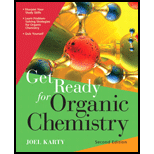
Concept explainers
(a)
Interpretation:
The complete, detailed mechanism for the given reaction is to be drawn.
Concept introduction:
Terminal
(b)
Interpretation:
The complete, detailed mechanism of the given reaction is to be drawn.
Concept introduction:
Alkynes can be prepared from dihaloalkanes (1, 1-dihaloalkanes or 1, 2-dihaloalkanes) by treating them with a strong base via back to back E2 reaction. When dihaloalkanes are treated with a strong base such as potassium hydroxide, a terminal alkyne is formed. This reaction does not require using three equivalents of
Trending nowThis is a popular solution!

Chapter 10 Solutions
Get Ready for Organic Chemistry
- Draw the complete, detailed mechanism and predict the products for the following reactions. HCN KCN, H2O (a) HCN NaOH, H20 (b)arrow_forwardA student proposes the following reaction mechanism for the reaction in Model 6. Which step inthis mechanism is least favorable? Explain your reasoning.arrow_forwardThe reaction shown here proceeds via a carbocation rearrangement. Draw a complete, detailed mechanism to account for the product. Explain why the carbocation rearrangement is favorable. CH;OH Brarrow_forward
- No reaction occurs when benzaldehyde and propenenitrile (acrylonitrile) are combined. In the presence of a catalytic amount of NaCN, however, the reaction shown here takes place. Draw a complete, detailed mechanism to account for these results. Hint: See Problem 18.70. NaCN TH. + CN `CN HOH,0, ELOHarrow_forwardDraw the complete, detailed mechanism for the reaction shown here and, using the mechanism, predict the major product. TSOH is a strong acid. -NH2 НО ? TSOH, C6H6, Aarrow_forwardThe following reaction is believed to proceed through the intermediate shown. Draw the complete, detailed mechanism that leads to the formation of that intermediate. NH, NH3 HO НО НО OH `NH2arrow_forward
- Draw the complete, detailed mechanism for the reaction shown here, which produces an amidine-a nitrogen analog to an ester. H NH C=N 1. 2. CH,ОH Benzonitrile An amidinearrow_forwardDraw the complete, detailed mechanism (curved arrows) for the following reaction. Br 2. H₂O OKarrow_forwardThe question states that this molecule can be prepared through X-C-C-C-X bond disconnection and asks to show the mechanism for the forward synthesis. please help!!arrow_forward
 Organic Chemistry: A Guided InquiryChemistryISBN:9780618974122Author:Andrei StraumanisPublisher:Cengage Learning
Organic Chemistry: A Guided InquiryChemistryISBN:9780618974122Author:Andrei StraumanisPublisher:Cengage Learning
